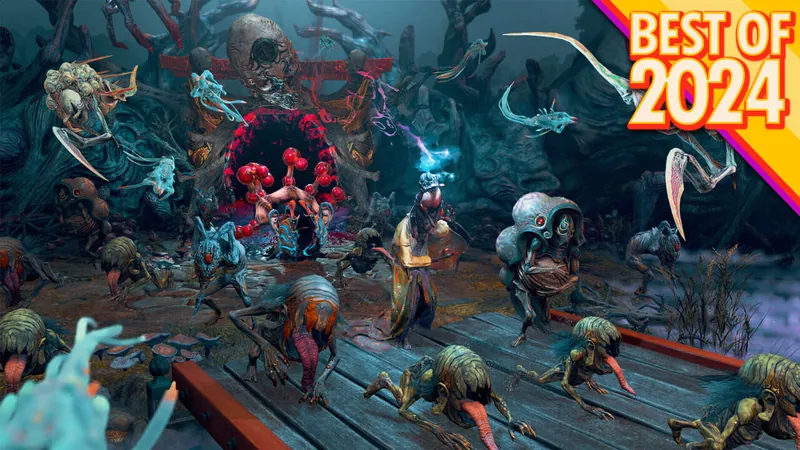
Kunitsu-Gami: Path of the Goddess - A Refreshing Throwback in Gaming
2024-12-28
Author: Kai
Capcom has surprised the gaming world with a hidden gem this year, though it's not the anticipated titles like Dragon’s Dogma 2 or the resplendent remasters of Dead Rising and Marvel vs. Capcom. Instead, we’re diving into the unique realm of Kunitsu-Gami: Path of the Goddess, a game that feels as if it has time-traveled from the early 2000s to grace us with its presence in 2024.
You might not have heard of Kunitsu-Gami, and that’s entirely understandable. Capcom itself acknowledged the game underperformed in sales during recent financial discussions, but to overlook it would be a disservice. It’s a history lesson wrapped in video game form, showcasing a vibrant tapestry of Japanese folklore and strategic gameplay reminiscent of days past.
In Kunitsu-Gami, you play as the brave warrior Soh, assigned to protect the divine maiden Yoshiro as she embarks on a mission to cleanse a sacred mountain. This objective transforms into a worker-management real-time strategy game, pulling players through a labyrinth of mystical creatures and spirits drawn from Japan's rich mythology.
Dynamic Gameplay with a Nostalgic Flair
The gameplay oscillates between day and night phases. During daylight, you rescue villagers and assign them vital roles—ranging from Woodsmen to Sumo wrestlers—who assist in erecting defenses and guiding Yoshiro safely to her goal. As night falls, the game shifts gears, focusing on defending against an onslaught of mythical enemies. Once you successfully fend off the threat, an extraordinary dance unfolds to purify the gate, a celebration that reinforces the game's ties to traditional Japanese culture.
What sets Kunitsu-Gami apart is its deliberate design approach. In an era where games are often bloated with expansive content and monetization strategies, Kunitsu-Gami offers a refreshing simplicity. The game features just one free DLC, offering cosmetic additions, and shyly refrains from pushing players toward excessive purchases. There's no need to gather endless collectibles or explore sprawling worlds; instead, the game delivers straightforward and engaging mechanics that invite players to invest their skills in unique strategies.
Artistry Rooted in Tradition
Visually, Kunitsu-Gami pays homage to the very essence of Japanese folklore. Influences can be seen in everything from the character movements, which reflect Kagura dance rituals, to the design of the monsters, echoing traditional yokai and bakemono art. Unlike modern titles that might focus on hyper-realism, Kunitsu-Gami presents a whimsical diorama-like world, crafting a narrative steeped in the lore of Japanese fairy tales.
The soundtrack enhances this experience, blending traditional Japanese instruments with modern sounds to create an atmosphere rich with nostalgia. Additionally, the creators went the extra mile to scan real-life traditional confections into the game, ensuring that each treat resonates with authenticity. Architectural designs and clothing are meticulously crafted to reflect historical accuracy, revealing a profound respect for the cultural heritage that inspired this creation.
Capcom's marketing efforts further intertwine with Japan's rich artistic history, as they collaborated with a Bunraku puppetry troupe to promote the game. This partnership not only highlights the game’s cultural tapestry but also infuses a sense of authenticity into its presentation.
In the tumultuous landscape of modern gaming, Kunitsu-Gami stands as a testament to what has been overshadowed: a pulse of creativity that resonates deeply with those who long for gaming experiences that harken back to simpler, yet far more profound, mechanics and themes.
As we watch the game garner cult status, it’s evident that Kunitsu-Gami isn’t merely a title to gloss over—it’s a celebration of culture, a strategic challenge, and a masterclass in artistic authenticity. It’s an invitation to experience a piece of historical preservation that not only respects its roots but also invites players into a world uniquely its own.




 Brasil (PT)
Brasil (PT)
 Canada (EN)
Canada (EN)
 Chile (ES)
Chile (ES)
 Česko (CS)
Česko (CS)
 대한민국 (KO)
대한민국 (KO)
 España (ES)
España (ES)
 France (FR)
France (FR)
 Hong Kong (EN)
Hong Kong (EN)
 Italia (IT)
Italia (IT)
 日本 (JA)
日本 (JA)
 Magyarország (HU)
Magyarország (HU)
 Norge (NO)
Norge (NO)
 Polska (PL)
Polska (PL)
 Schweiz (DE)
Schweiz (DE)
 Singapore (EN)
Singapore (EN)
 Sverige (SV)
Sverige (SV)
 Suomi (FI)
Suomi (FI)
 Türkiye (TR)
Türkiye (TR)
 الإمارات العربية المتحدة (AR)
الإمارات العربية المتحدة (AR)